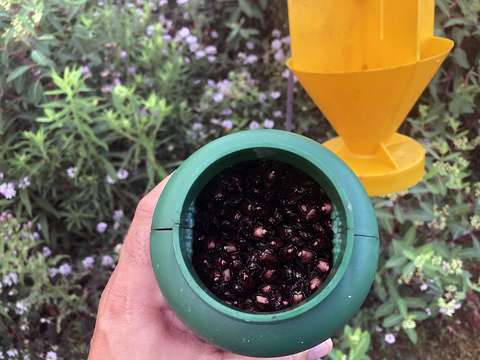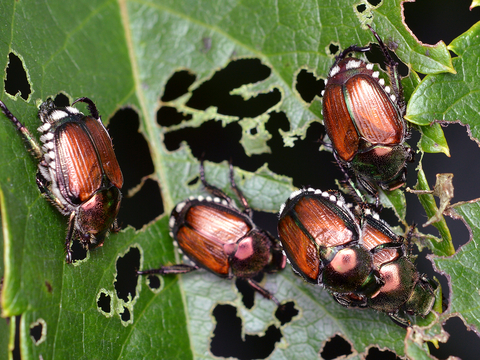After spending the spring eating up lawns, Japanese beetle adults currently are or soon will be emerging across Minnesota. This invasive beetle spends the spring and late summer as a grub feeding on lawns, but in the middle of summer, adult beetles feed on leaves. They like to feed on over 300 species of plants, and have a habit of congregating in large numbers.
While the University of Minnesota is still performing research to understand this pest, one thing we do know is Japanese beetle traps do not reduce beetle feeding.
What do we mean by this? It isn’t hard to find pictures of the lure-baited funnels and bags overflowing with beetles. So yes, we know beetles are attracted to traps. In many areas of Minnesota, such as in the metro, Japanese beetles are abundant enough that we cannot trap the problem away.
The question instead is, does your yard or garden benefit from putting up a trap? The answer is, most likely, no.
Luring beetles to your yard
Japanese beetle traps are baited with lures. These lures may have the scent of flowers or the scent of beetle pheromones (sometimes both). These smells travel through the air and the beetles pick up on the scent using their antenna, inviting the beetle to come on over. Beetles end up both inside and outside the trap, and as large numbers of beetles congregate, they put off more pheromones that attract more beetles, whether they are in the trap or not.
This may not seem like a big deal, but remember, in many areas of the state, Japanese beetles are abundant. In trapping around the metro area, UMN researchers regularly captured hundreds (and occasionally thousands) of beetles a week. It is estimated that only 75% of beetles attracted to a trap end up in the trap, so in the end, you can be drawing large numbers of Japanese beetles to your area, while only capturing some of them.
Studies have shown that traps lead to more plant damage in the areas they are placed. One study found that a trap placed alone led to nearby vegetation having more damage than in similar areas where no traps were placed.
Trap sellers may highlight how placement can make traps more effective. One study investigated the impact of where traps were placed in terms of their number (one trap or multiple traps), location (near vulnerable plants or not), and wind direction (upwind or downwind from susceptible vegetation). Regardless of number or placement, the areas around the traps had more beetle feeding damage than if there had been no trap at all.
While the masses of gleaming beetles are unsightly and the holey leaves they leave behind annoying, Japanese beetles aren't going anywhere and Minnesotans will have to learn to live with them. For your most prized plants, tap beetles off the plant and into a bucket of soapy water.
Learn more about Japanese beetles and management that works.
F. Carter Gordon, Daniel A. Potter, Efficiency of Japanese Beetle (Coleoptera: Scarabaeidae) Traps in Reducing Defoliation of Plants in the Urban Landscape and Effect on Larval Density in Turf, Journal of Economic Entomology, Volume 78, Issue 4, 1 August 1985, Pages 774–778, https://doi.org/10.1093/jee/78.4.774
Carter F. Gordon, Daniel A. Potter, Japanese Beetle (Coleoptera: Scarabaeidae) Traps: Evaluation of Single and Multiple Arrangements for Reducing Defoliation in Urban Landscape, Journal of Economic Entomology, Volume 79, Issue 5, 1 October 1986, Pages 1381–1384, https://doi.org/10.1093/jee/79.5.1381



